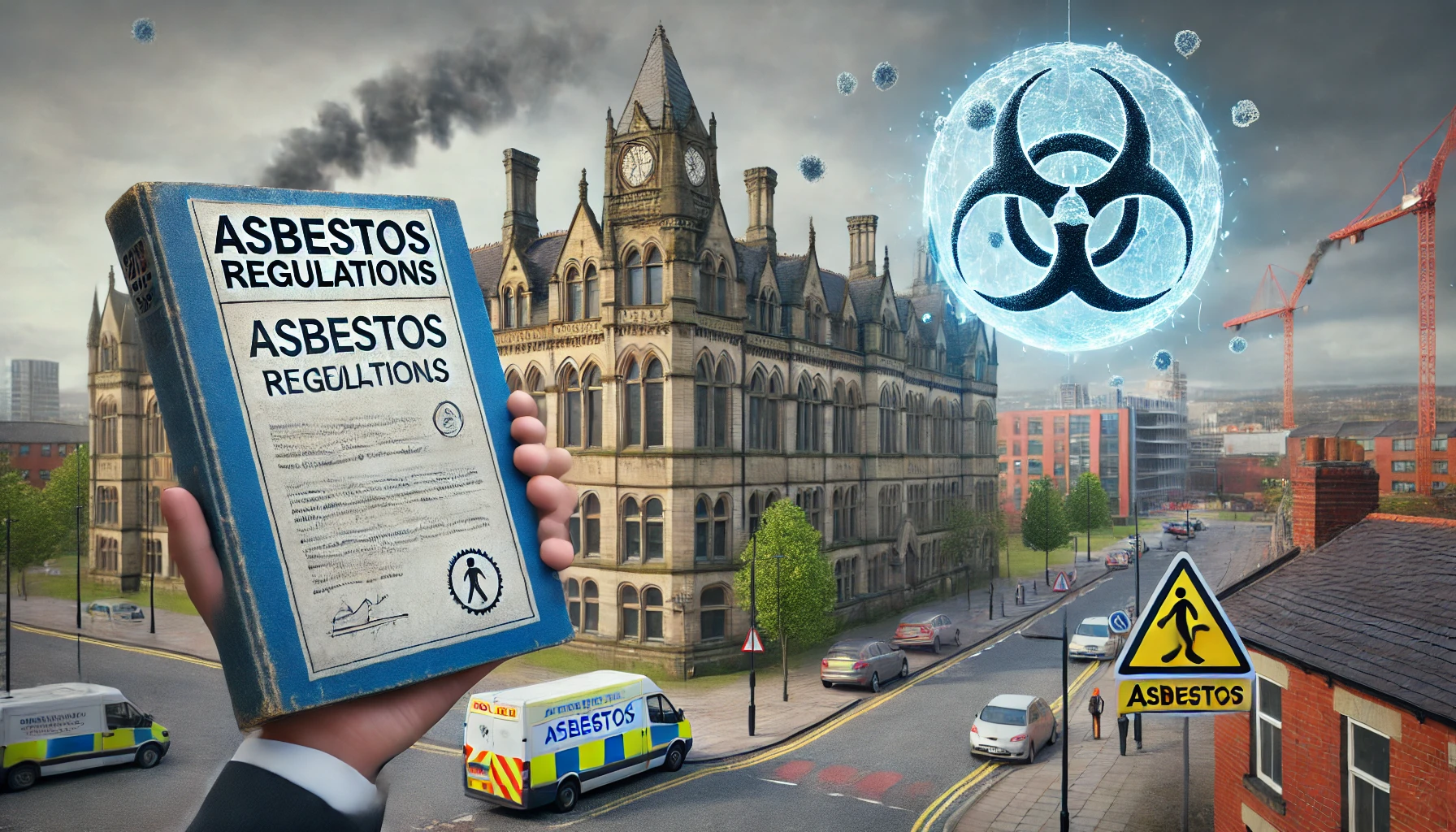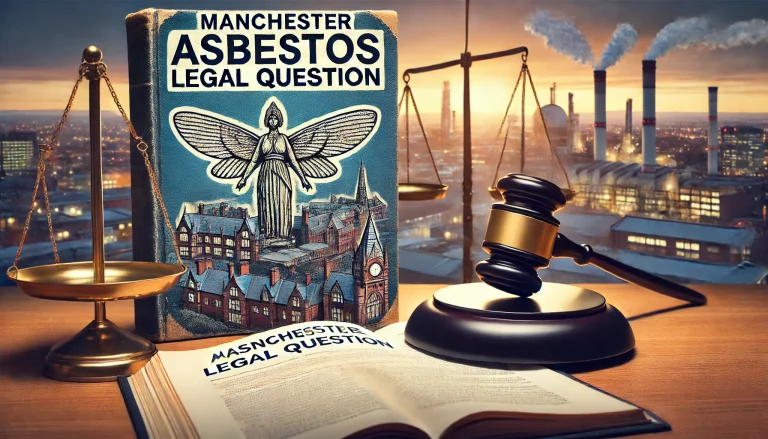Asbestos is a group of naturally occurring minerals that have been used for decades in construction and industrial applications due to their heat resistance and durability. For much of the 20th century, asbestos was used in a wide range of materials, from insulation to fireproofing, making it a popular choice for building and manufacturing.
However, over time, it became clear that exposure to asbestos fibers can cause severe health issues, including mesothelioma, lung cancer, and asbestosis. These diseases often develop long after exposure, making it difficult for victims to seek help in time. In Manchester, the Manchester asbestos legal question has become a critical issue as many buildings were constructed during the height of asbestos use, requiring careful management of asbestos to protect individuals and organizations.
Asbestos in Manchester: A Historical Perspective
Manchester, like many industrial cities, has a long history of asbestos use in its factories, schools, and public buildings. During the 20th century, the city was a hub of manufacturing and industry, with a large number of commercial and industrial buildings being constructed using materials containing asbestos. These buildings were often used for years without concern for the risks posed by the material.
Even though asbestos use was outlawed in the UK in 1999, asbestos-containing materials (ACMs) can still be found in many older Manchester buildings. While ACMs are not dangerous when left undisturbed, the risks become significant when these materials are damaged or disturbed during construction, renovation, or natural decay. Over time, the city has recognized the importance of identifying and managing these hazards to protect residents and workers.
The UK’s Legal Foundation for Asbestos Management
In the UK, the management of asbestos is strictly regulated under the Control of Asbestos Regulations 2012, which are part of a broader set of health and safety laws designed to protect people from exposure. These regulations outline the responsibilities of property owners, employers, and contractors when it comes to identifying, managing, and removing asbestos.
Some of the key requirements of these regulations include:
- Asbestos Surveys: Property owners, especially those of non-domestic buildings, are required by law to conduct asbestos surveys. These surveys help identify any ACMs that may be present in the building and determine the level of risk associated with them.
- Asbestos Registers: If asbestos is identified, an asbestos register must be created and maintained. This register is a comprehensive list of all known asbestos-containing materials in the building, detailing their locations and conditions.
- Asbestos Management Plans: Property owners must develop and implement management plans to handle ACMs safely. These plans must include details on how asbestos will be monitored, how it will be maintained, and what procedures will be followed if the materials are disturbed.
- Safe Removal: A licensed contractor must remove asbestos if it needs to be done. These professionals follow strict protocols to prevent the release of asbestos fibers into the air during removal.
Responsibilities of Property Owners, Employers, and Contractors
The legal obligations surrounding asbestos are not limited to property owners; they extend to employers and contractors as well.
Property Owners:
- Legal Duty to Manage Asbestos: Property owners have a legal responsibility to manage the risks associated with asbestos in their buildings. This includes conducting surveys, maintaining registers, and ensuring safe management of ACMs.
- Action Plans for Removal: If removal or repair is necessary, property owners must ensure that it is done by qualified professionals, and that the work adheres to legal safety standards.
Employers:
- Workplace Safety: Employers are legally required to ensure the safety of their employees when working in environments that may contain asbestos. This includes conducting risk assessments, providing proper training, and ensuring the use of personal protective equipment (PPE).
- Training and Awareness: Employees who may be exposed to asbestos (such as construction workers) must receive proper training in how to handle and avoid asbestos safely.
Contractors:
- Licensed Contractors: Any work that involves the disturbance or removal of asbestos must be carried out by a licensed asbestos contractor. These contractors are trained in handling asbestos safely and have the proper equipment to minimize risks.
Health Risks of Asbestos
Serious and sometimes fatal illnesses can result from asbestos exposure. These conditions can take decades to manifest, which is why many people do not realize they have been affected until it’s too late.
- Mesothelioma: This is a rare but aggressive cancer that affects the lining of the lungs (pleura) or abdomen (peritoneum). Mesothelioma is almost exclusively caused by asbestos exposure, and its symptoms may not appear until 20 to 50 years after exposure.
- Asbestosis: Inhaling asbestos fibers can result in asbestosis, a persistent lung illness. It leads to scarring of the lung tissue, causing shortness of breath, coughing, and difficulty breathing.
- Lung Cancer: The risk is higher for those who have smoked and been exposed to asbestos, but the disease can affect non-smokers as well.
These diseases often have a long latency period, meaning individuals may not show symptoms until many years after exposure. This makes early detection challenging and the legal process more complicated.
Legal Rights for Individuals Affected by Asbestos
For individuals diagnosed with an asbestos-related disease, there are legal avenues to seek compensation for the suffering and financial burden caused by the illness. Legal claims can be made against:
- Employers: If an individual was exposed to asbestos at work due to an employer’s negligence (such as failure to provide a safe working environment), they may be entitled to compensation.
- Property Owners: If a person’s illness is linked to exposure from a public or private building, they may be able to file a claim against the building owner for not adequately managing asbestos risks.
- Manufacturers: In some cases, asbestos-related claims can be made against manufacturers who produce asbestos-containing products.
- Time Limits for Claims: Victims of asbestos-related diseases generally have three years from the date of their diagnosis or from when they became aware that their illness was related to asbestos exposure to file a claim. It’s crucial to seek legal advice as soon as possible, as missing this window can prevent a claim from being made.
Manchester’s Specific Asbestos Concerns
In Manchester, many of the city’s older industrial buildings, schools, and public housing still contain asbestos. As a result, the risk of exposure remains present, especially during construction or renovation work. The local government and health authorities have made significant efforts to address these risks, including funding asbestos surveys and removal projects in public buildings.
However, many private property owners and businesses may not be fully aware of their responsibilities under the law, which is why public education campaigns are essential to raise awareness about the risks of asbestos exposure.
How to Protect Yourself from Asbestos Exposure
If you are concerned about potential asbestos exposure in your home, workplace, or public building, there are several steps you can take:
For Property Owners:
- Ensure regular asbestos surveys are conducted.
- If asbestos is found, implement a proper management plan or hire a licensed contractor to safely remove it.
For Employees:
- If you work in an environment where asbestos may be present, ensure you receive appropriate training.
- Always use the recommended PPE and follow safety procedures.
For Residents:
- Report any suspected asbestos hazards to your local council.
- Be cautious when renovating or disturbing old buildings, as this can release dangerous asbestos fibers.
Conclusion
Asbestos remains a major health concern in Manchester, especially in older buildings where it was extensively used. The Manchester asbestos legal question highlights the importance of strict adherence to legal frameworks, such as the Control of Asbestos Regulations 2012, which mandate that property owners, employers, and contractors take responsibility for identifying and managing asbestos risks.
For those suffering from asbestos-related illnesses, legal pathways exist to pursue compensation, but timely action is critical due to strict claim deadlines. By understanding asbestos management laws and their rights, Manchester residents can take proactive steps to safeguard their health and protect their communities from the long-term dangers of asbestos exposure.
FAQs on Manchester Asbestos Legal Questions
What is asbestos, and why is it dangerous?
Asbestos is a group of heat-resistant minerals that were widely used in construction and manufacturing for insulation and fireproofing. When asbestos-containing materials (ACMs) are disturbed, they release tiny fibers into the air. Inhalation of these fibers can cause serious health issues, including mesothelioma, asbestosis, and lung cancer, often decades after exposure.
Who is responsible for managing asbestos in buildings?
In Manchester and across the UK, the responsibility lies with property owners and occupiers of non-domestic buildings. They must conduct asbestos surveys, maintain a register, and implement management plans as required by the Control of Asbestos Regulations 2012. Employers also share responsibility for ensuring workplace safety.
What should I do if I suspect asbestos in my home or workplace?
If you suspect asbestos in your home or workplace:
- Do not disturb the material, as it can release harmful fibers.
- For workplaces or rental properties, report it to the property owner or employer.
- Hire a licensed asbestos professional to assess and manage the material if necessary.
Can I file a claim if I have an asbestos-related illness?
Yes, individuals diagnosed with an asbestos-related illness, such as mesothelioma, can file a compensation claim. Claims can be made against negligent employers, property owners, or manufacturers. The claim must usually be filed within three years of the diagnosis.
How do I safely remove asbestos from a building?
Asbestos removal should always be carried out by licensed professionals. They follow strict safety protocols to minimize risks, such as using protective equipment, sealing off the area, and disposing of the materials in approved facilities. Attempting to remove asbestos yourself can be extremely dangerous and is not recommended.




